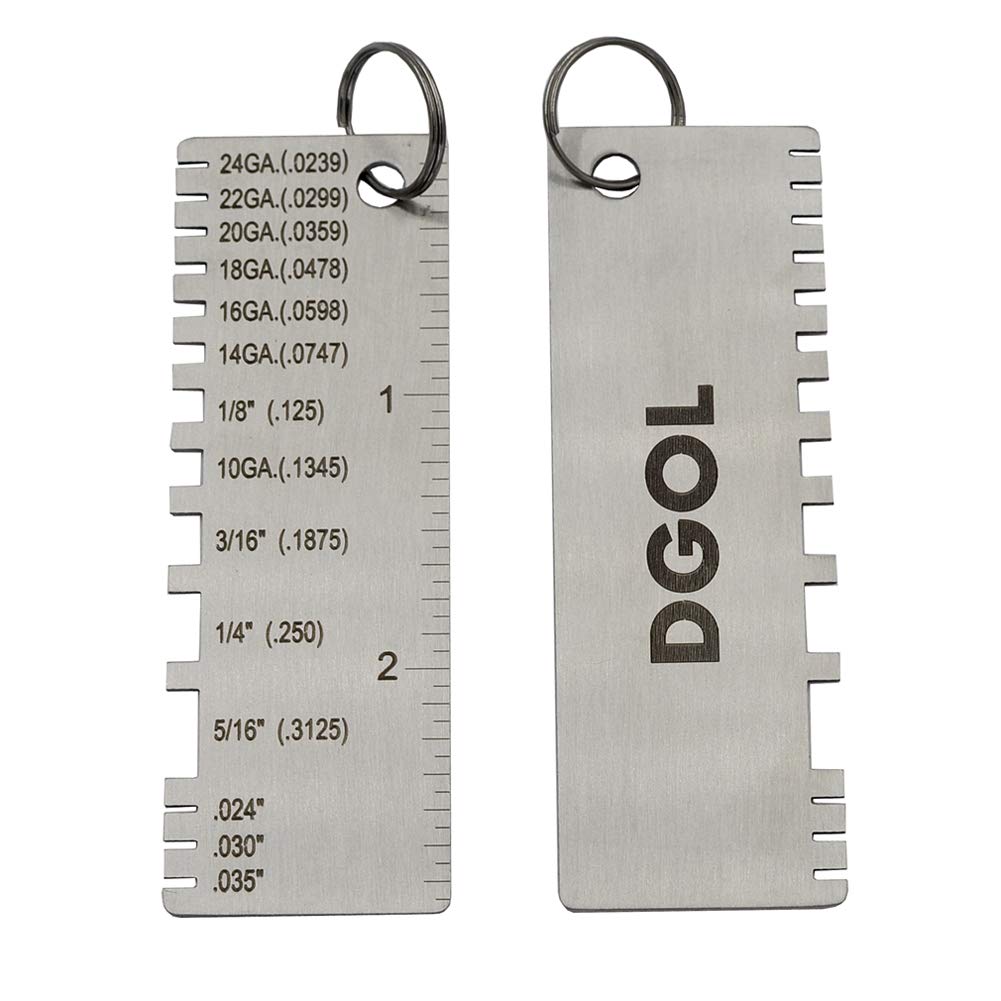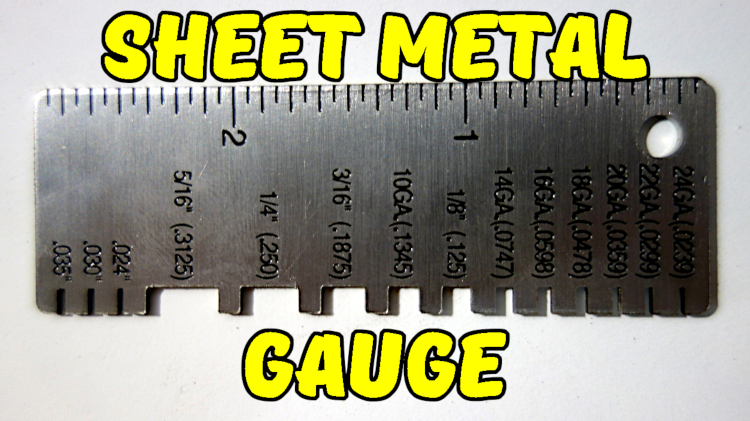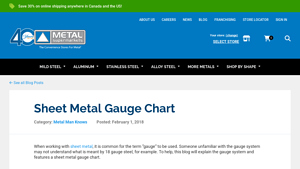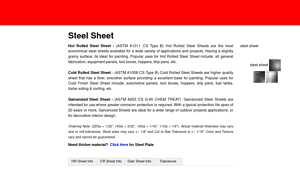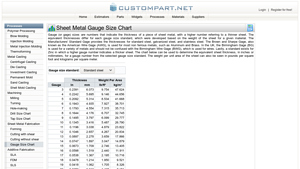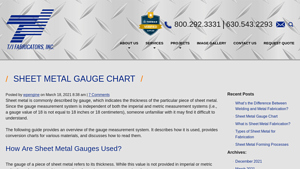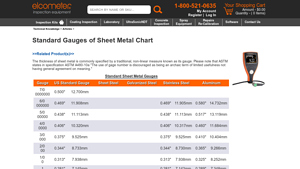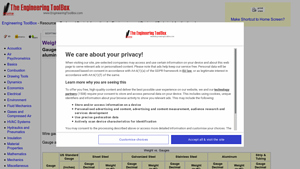8 Gauge Sheet Metal Guide: Type, Cost, Top List…
Introduction: Navigating the Global Market for 8 gauge sheet metal
Navigating the global market for 8 gauge sheet metal presents unique challenges for international B2B buyers, especially those sourcing materials for demanding applications in industries such as construction, automotive, and manufacturing. Understanding the nuances of gauge specifications, including how 8 gauge translates to specific thickness measurements—approximately 0.1644 inches or 4.175 millimeters—can be daunting. This guide aims to demystify the complexities surrounding 8 gauge sheet metal, offering invaluable insights into various types, applications, and sourcing strategies.
In this comprehensive resource, we will explore the diverse applications of 8 gauge sheet metal across multiple sectors, delve into the intricacies of supplier vetting, and provide a detailed overview of cost factors that influence purchasing decisions. By understanding these key elements, B2B buyers from regions such as Africa, South America, the Middle East, and Europe—including major markets like Brazil and Germany—will be equipped to make informed decisions that align with their operational needs.
Ultimately, this guide is designed to empower buyers by providing actionable insights and expert recommendations, ensuring that they navigate the global market with confidence and precision. Whether you are sourcing for large-scale projects or specific custom applications, the knowledge within these pages will serve as a crucial tool in optimizing your procurement processes for 8 gauge sheet metal.
Understanding 8 gauge sheet metal Types and Variations
| Type Name | Key Distinguishing Features | Primary B2B Applications | Brief Pros & Cons for Buyers |
|---|---|---|---|
| Mild Steel | High tensile strength, cost-effective | Construction, automotive, industrial parts | Pros: Affordable, versatile; Cons: Prone to rust without coating |
| Stainless Steel | Corrosion-resistant, aesthetic finish | Food processing, chemical equipment | Pros: Long-lasting, hygienic; Cons: Higher cost compared to mild steel |
| Aluminum | Lightweight, good corrosion resistance | Aerospace, transportation, packaging | Pros: Lightweight, easy to fabricate; Cons: Lower strength than steel |
| Galvanized Steel | Coated for enhanced corrosion resistance | Outdoor structures, HVAC systems | Pros: Durable, weather-resistant; Cons: Limited high-temperature applications |
| Copper | Excellent electrical conductivity, malleable | Electrical applications, roofing | Pros: High conductivity, antimicrobial; Cons: Expensive, can tarnish over time |
What Are the Key Characteristics of Mild Steel 8 Gauge Sheet Metal?
Mild steel is one of the most commonly used materials in various industries due to its high tensile strength and cost-effectiveness. It typically features a thickness of 0.1644 inches (4.175 mm) for 8 gauge. This type of sheet metal is ideal for applications in construction, automotive manufacturing, and the production of industrial components. B2B buyers should consider its susceptibility to rust, which necessitates protective coatings for outdoor or humid environments.
How Does Stainless Steel 8 Gauge Sheet Metal Stand Out?
Stainless steel offers a unique combination of strength and corrosion resistance, making it suitable for environments where hygiene is critical, such as food processing and chemical manufacturing. With a thickness of 0.17187 inches (4.365 mm), this material is ideal for applications requiring durability and aesthetic appeal. Buyers should weigh the higher initial costs against the long-term benefits of reduced maintenance and longevity in corrosive environments.
In What Situations Is Aluminum 8 Gauge Sheet Metal Preferred?
Aluminum is favored for its lightweight nature and good corrosion resistance, with an 8 gauge thickness of 0.1285 inches (3.264 mm). This makes it particularly suitable for industries such as aerospace, transportation, and packaging, where weight savings are critical. B2B purchasers should note that while aluminum is easier to fabricate, it generally has lower strength compared to steel, which may limit its use in heavy-duty applications.
Why Choose Galvanized Steel 8 Gauge Sheet Metal?
Galvanized steel features a protective zinc coating that enhances its corrosion resistance, making it a popular choice for outdoor structures and HVAC systems. With a thickness of 0.1681 inches (4.269 mm), it provides durability in exposed environments. Buyers should consider its benefits in terms of longevity and reduced maintenance, although it may not perform well in high-temperature applications due to the melting point of the zinc coating.
What Are the Advantages of Copper 8 Gauge Sheet Metal?
Copper is renowned for its exceptional electrical conductivity and malleability, making it an ideal choice for electrical applications and roofing materials. An 8 gauge copper sheet measures 0.165 inches (4.191 mm) in thickness. While it offers significant advantages in conductivity and antimicrobial properties, buyers should be aware of its higher cost and potential for tarnishing over time, which may necessitate additional maintenance.
Key Industrial Applications of 8 gauge sheet metal
| Industry/Sector | Specific Application of 8 gauge sheet metal | Value/Benefit for the Business | Key Sourcing Considerations for this Application |
|---|---|---|---|
| Construction | Structural components for buildings and bridges | Provides strength and durability for load-bearing structures | Ensure compliance with local building codes and standards |
| Automotive | Chassis and body panels for vehicles | Enhances vehicle safety and performance | Consider corrosion resistance and weight specifications |
| Manufacturing | Machine housings and frames | Offers robust protection for sensitive equipment | Focus on precision cutting and fabrication capabilities |
| Energy | Components for power generation equipment | Supports efficiency and reliability in energy production | Evaluate material compatibility with environmental conditions |
| HVAC | Ductwork and enclosures | Improves energy efficiency and airflow management | Check for thermal conductivity and insulation properties |
How is 8 Gauge Sheet Metal Used in Construction?
In the construction industry, 8 gauge sheet metal is predominantly used for structural components such as beams, columns, and reinforcements in buildings and bridges. The thickness of 8 gauge provides the necessary strength to support heavy loads, ensuring stability and safety in construction projects. International buyers, particularly from regions like Africa and South America, must consider local building codes and environmental factors when sourcing this material to ensure compliance and durability.
What Role Does 8 Gauge Sheet Metal Play in the Automotive Sector?
Within the automotive industry, 8 gauge sheet metal is crucial for manufacturing chassis and body panels. Its robust nature enhances vehicle safety by providing structural integrity during collisions, while also contributing to overall performance through weight management. Buyers from Europe and the Middle East should prioritize suppliers that offer materials with high corrosion resistance, particularly given the varying climates and road conditions in these regions.
How is 8 Gauge Sheet Metal Utilized in Manufacturing?
In manufacturing, 8 gauge sheet metal is often used to create machine housings and frames that require a sturdy and protective shell. This application is vital for safeguarding sensitive equipment from external damage and ensuring operational efficiency. B2B buyers should focus on suppliers that can offer precise cutting and fabrication services to meet specific design requirements, especially when dealing with complex machinery.
What is the Importance of 8 Gauge Sheet Metal in Energy Applications?
The energy sector utilizes 8 gauge sheet metal for components in power generation equipment, such as housings for turbines and generators. The material’s strength and durability are essential for maintaining efficiency and reliability in energy production. Buyers should assess the compatibility of the sheet metal with various environmental conditions, ensuring that it can withstand factors such as heat and moisture, which are prevalent in many energy facilities.
How is 8 Gauge Sheet Metal Applied in HVAC Systems?
In HVAC systems, 8 gauge sheet metal is commonly used for ductwork and enclosures, helping to optimize energy efficiency and airflow management. The thickness of the material ensures durability against wear and tear, contributing to the longevity of the system. Buyers should evaluate the thermal conductivity and insulation properties of the sheet metal to ensure it meets the specific needs of their HVAC applications, particularly in diverse climates across Africa, Europe, and the Middle East.
3 Common User Pain Points for ‘8 gauge sheet metal’ & Their Solutions
Scenario 1: Confusion Over Gauge Specifications
The Problem: Many B2B buyers encounter confusion when it comes to understanding the gauge system for sheet metal, particularly with 8 gauge options. Different materials have different thicknesses associated with the same gauge number. For instance, 8 gauge steel measures approximately 0.1644 inches, while 8 gauge aluminum measures about 0.1285 inches. This inconsistency can lead to incorrect material selection, which can compromise the structural integrity of the final product and result in costly rework.
The Solution: To mitigate this issue, buyers should utilize detailed gauge conversion charts specific to the materials they are sourcing. Establish a clear process for double-checking specifications by consulting a standardized gauge chart before placing an order. It’s also beneficial to engage suppliers who provide comprehensive material data sheets that outline the thickness and mechanical properties of their 8 gauge sheet metal products. Regular training sessions on gauge specifications for the procurement team can further reduce confusion and ensure that the correct materials are always sourced.
Scenario 2: Sourcing High-Quality 8 Gauge Sheet Metal
The Problem: Sourcing high-quality 8 gauge sheet metal can be challenging, particularly for companies operating in regions with less access to reliable suppliers. Buyers may struggle to find vendors who can guarantee material quality, which is crucial for applications such as construction, automotive parts, and industrial machinery. Inconsistent quality can lead to product failures, safety issues, and damage to the company’s reputation.
The Solution: To address quality concerns, buyers should conduct thorough due diligence when selecting suppliers. This includes verifying certifications such as ISO 9001 or other relevant industry standards that indicate quality management systems. Establishing long-term relationships with reputable suppliers can also ensure a consistent supply of high-quality materials. Additionally, requesting samples before making bulk purchases allows buyers to assess material quality firsthand. Collaborating with suppliers who offer transparency regarding their sourcing and manufacturing processes can further enhance confidence in the material quality.
Scenario 3: Difficulty in Fabrication and Machining
The Problem: Fabricating and machining 8 gauge sheet metal presents its own set of challenges. Buyers often face difficulties in cutting, bending, and welding the material due to its thickness. This can lead to increased labor costs and longer project timelines. Inadequate tools or methods can also result in rough edges or warping, negatively impacting the final product’s quality.
The Solution: To improve fabrication efficiency, buyers should invest in the right tools and equipment tailored for handling 8 gauge sheet metal. This includes high-quality plasma cutters, laser cutting machines, and specialized bending equipment. It’s also essential to provide training for staff on best practices for working with thicker metals, focusing on techniques that minimize distortion and ensure precision. Collaborating with local fabrication shops that specialize in sheet metal work can provide additional expertise and resources. Finally, implementing a robust quality control process during fabrication can help catch issues early, reducing the risk of costly errors down the line.
Strategic Material Selection Guide for 8 gauge sheet metal
What Are the Key Properties of Common Materials for 8 Gauge Sheet Metal?
When selecting 8 gauge sheet metal, it is crucial to consider the material properties that will impact product performance. The most common materials include mild steel, stainless steel, aluminum, and galvanized steel. Each material offers distinct advantages and disadvantages, making them suitable for different applications.
How Does Mild Steel Perform as 8 Gauge Sheet Metal?
Mild steel is known for its excellent weldability and formability, making it a popular choice in various industries. It has a tensile strength of approximately 370 MPa and can withstand moderate temperatures and pressures. However, it is prone to corrosion if not properly treated or coated.
Pros: Mild steel is relatively inexpensive, widely available, and easy to machine. It is suitable for applications such as structural components and automotive parts.
Cons: Its susceptibility to rust can be a significant drawback, particularly in humid or corrosive environments. Additionally, it may require additional coatings or treatments to enhance its durability.
Impact on Application: Mild steel is compatible with various media but may require protective coatings for applications involving moisture or chemicals.
Considerations for International Buyers: Compliance with ASTM standards is essential, especially for industries in Europe and the Middle East. Buyers should also consider local availability and the cost of protective coatings.
What Are the Benefits of Using Stainless Steel for 8 Gauge Sheet Metal?
Stainless steel is renowned for its corrosion resistance, making it ideal for applications exposed to harsh environments. With a tensile strength of around 520 MPa, it can handle higher pressures and temperatures than mild steel.
Pros: Its durability and aesthetic appeal make it suitable for food processing, medical equipment, and architectural applications. Stainless steel also requires minimal maintenance.
Cons: The primary drawback is its higher cost compared to mild steel. Additionally, it can be more challenging to fabricate, requiring specialized tools and techniques.
Impact on Application: Stainless steel is compatible with a wide range of media, including corrosive substances, making it a preferred choice in chemical processing industries.
Considerations for International Buyers: Compliance with DIN standards is crucial for buyers in Germany and Europe. Understanding the specific grade of stainless steel (e.g., 304, 316) is essential for ensuring suitability for specific applications.
How Does Aluminum Compare as an 8 Gauge Sheet Metal Option?
Aluminum is lightweight and offers excellent corrosion resistance, making it a favored choice in industries where weight is a concern, such as aerospace and automotive. It has a tensile strength of approximately 310 MPa, which is lower than that of mild and stainless steel.
Pros: Aluminum is easy to work with and can be anodized for enhanced corrosion resistance. Its lightweight nature can lead to cost savings in transportation and installation.
Cons: The lower tensile strength may limit its use in high-stress applications. Additionally, aluminum can be more expensive than mild steel.
Impact on Application: Aluminum is suitable for applications involving moisture and chemicals but may not be ideal for high-pressure environments.
Considerations for International Buyers: Buyers should be aware of regional standards such as JIS in Japan and ASTM in the U.S. Understanding the specific alloy used is also critical for ensuring performance.
What Role Does Galvanized Steel Play in 8 Gauge Sheet Metal Applications?
Galvanized steel is mild steel that has been coated with zinc to enhance its corrosion resistance. It retains the weldability and formability of mild steel while providing added protection against rust.
Pros: The zinc coating extends the lifespan of the steel, making it suitable for outdoor applications. It is also relatively cost-effective compared to stainless steel.
Cons: The coating can be damaged, exposing the underlying steel to corrosion. Additionally, galvanized steel may not be suitable for high-temperature applications.
Impact on Application: Galvanized steel is ideal for construction and outdoor structures where exposure to moisture is a concern.
Considerations for International Buyers: Compliance with ASTM standards is important, especially for construction projects in regions like Africa and South America. Understanding local regulations regarding coatings and materials is also essential.
Summary Table of 8 Gauge Sheet Metal Materials
| Material | Typical Use Case for 8 gauge sheet metal | Key Advantage | Key Disadvantage/Limitation | Relative Cost (Low/Med/High) |
|---|---|---|---|---|
| Mild Steel | Structural components, automotive parts | Cost-effective and easy to fabricate | Prone to corrosion without treatment | Low |
| Stainless Steel | Food processing, medical equipment | Excellent corrosion resistance | Higher cost and fabrication complexity | High |
| Aluminum | Aerospace, automotive applications | Lightweight and corrosion-resistant | Lower tensile strength | Medium |
| Galvanized Steel | Outdoor structures, construction | Enhanced corrosion resistance | Coating can be damaged | Medium |
This guide provides a comprehensive overview of the strategic material selection process for 8 gauge sheet metal, catering to the specific needs of international B2B buyers across various regions.
In-depth Look: Manufacturing Processes and Quality Assurance for 8 gauge sheet metal
What Are the Key Manufacturing Processes for 8 Gauge Sheet Metal?
The manufacturing of 8 gauge sheet metal involves several critical stages, each designed to ensure precision and quality. Understanding these processes is essential for B2B buyers looking to source reliable materials for their projects.
1. Material Preparation: How Is 8 Gauge Sheet Metal Initially Processed?
The first step in manufacturing 8 gauge sheet metal is material preparation. This typically involves selecting high-quality raw materials, such as mild steel or stainless steel, based on the intended application. The chosen material is then cut to size using techniques like shearing or plasma cutting.
Next, the sheets undergo surface cleaning to remove any impurities, rust, or contaminants. This is crucial as it affects the adhesion of coatings and finishes later in the process. Effective cleaning methods include sandblasting or chemical cleaning, ensuring the surface is ready for forming.
2. What Forming Techniques Are Commonly Used for 8 Gauge Sheet Metal?
Once the material is prepared, the next stage is forming. Various techniques can be employed, including:
- Bending: This is achieved using press brakes that apply force to bend the metal at specific angles. For 8 gauge sheet metal, precision is vital to avoid cracking.
- Roll Forming: This continuous process shapes the metal by passing it through a series of rollers. It’s ideal for producing long lengths of metal with consistent cross-sections.
- Stamping: This technique involves using dies to cut or shape the metal. Stamping is effective for producing complex shapes and high-volume runs.
Each forming method is selected based on the specific requirements of the end product, balancing factors such as cost, complexity, and material characteristics.
3. How Is Assembly Conducted for 8 Gauge Sheet Metal Products?
After forming, assembly may be required, especially for products that consist of multiple parts. This stage often involves welding, riveting, or mechanical fastening.
Welding techniques, such as MIG (Metal Inert Gas) or TIG (Tungsten Inert Gas), are commonly used for joining pieces of 8 gauge sheet metal. The choice of technique depends on the application and desired strength of the joint. Proper training and equipment are essential to ensure high-quality welds that meet industry standards.
4. What Finishing Processes Enhance the Quality of 8 Gauge Sheet Metal?
Finishing processes are vital for improving the aesthetic appeal and durability of 8 gauge sheet metal products. Common finishing techniques include:
- Coating: Protective coatings, such as paint or powder coating, enhance corrosion resistance and improve appearance. The application process must be thorough to ensure even coverage.
- Plating: Techniques like galvanizing or electroplating can be applied to enhance surface properties, particularly for applications exposed to harsh environments.
- Deburring: This process removes sharp edges and burrs from the metal, ensuring safety and improving the overall quality of the finished product.
These finishing processes not only enhance the functionality of the metal but also contribute to its longevity in various applications.
What Quality Assurance Measures Are Essential for 8 Gauge Sheet Metal?
Quality assurance (QA) is critical in ensuring that 8 gauge sheet metal meets international standards and customer specifications. A robust QA program typically includes several components.
1. What International Standards Should B2B Buyers Consider?
For B2B buyers, understanding relevant international standards is crucial. ISO 9001 is a widely recognized standard for quality management systems. It ensures that manufacturers consistently meet customer and regulatory requirements.
Other industry-specific certifications may also apply, depending on the application. For example, CE marking is essential for products sold in the European market, while API (American Petroleum Institute) certifications are relevant for products used in the oil and gas industry. Buyers should verify that suppliers hold the necessary certifications for their specific market and application.
2. How Are Quality Control Checkpoints Established?
Quality control (QC) checkpoints are integral to the manufacturing process. These include:
- Incoming Quality Control (IQC): This step involves inspecting raw materials upon arrival to ensure they meet specified requirements.
- In-Process Quality Control (IPQC): During manufacturing, regular inspections are conducted to monitor processes and detect defects early.
- Final Quality Control (FQC): Once production is complete, a final inspection ensures that the finished product meets all specifications before shipment.
Each checkpoint is designed to minimize defects and ensure that the final product is of the highest quality.
3. What Testing Methods Are Commonly Used for 8 Gauge Sheet Metal?
Various testing methods are employed to assess the quality of 8 gauge sheet metal. Common techniques include:
- Visual Inspection: A straightforward method to identify surface defects and inconsistencies.
- Dimensional Testing: Ensures that the metal meets specified thickness and size requirements.
- Mechanical Testing: This may include tensile testing, bend testing, and hardness testing to assess the material’s properties and performance under stress.
B2B buyers should request detailed reports on these tests to verify that the products meet their specifications.
How Can B2B Buyers Verify Supplier Quality Control?
To ensure reliable sourcing, B2B buyers must take proactive steps to verify a supplier’s quality control processes.
1. What Audit Procedures Should Be Followed?
Conducting supplier audits is an effective way to assess the manufacturing processes and quality assurance measures in place. This includes evaluating their production capabilities, quality control systems, and compliance with international standards.
Buyers should prepare a checklist of criteria to evaluate during the audit, focusing on areas such as equipment maintenance, staff training, and documentation practices.
2. How Important Are Quality Reports and Third-Party Inspections?
Requesting quality reports is essential for transparency. Suppliers should provide documentation demonstrating compliance with relevant standards and results from quality control testing.
Additionally, engaging third-party inspection services can provide an unbiased assessment of the manufacturing processes and product quality. These inspections can be especially valuable for international buyers who may not have the capability to perform on-site audits.
Conclusion: Why Quality Assurance Matters for 8 Gauge Sheet Metal Suppliers
For B2B buyers sourcing 8 gauge sheet metal, understanding the manufacturing processes and quality assurance measures is vital. By focusing on supplier audits, quality reports, and compliance with international standards, buyers can ensure they receive high-quality materials that meet their project requirements. This diligence not only safeguards investments but also enhances the overall reliability of their supply chain.
Practical Sourcing Guide: A Step-by-Step Checklist for ‘8 gauge sheet metal’
To successfully procure 8 gauge sheet metal, it’s essential to follow a structured approach that ensures you meet your project requirements while minimizing risks. This checklist will guide you through the critical steps necessary for effective sourcing.
Step 1: Define Your Technical Specifications
Before initiating the sourcing process, clearly define the technical specifications of the 8 gauge sheet metal you require. This includes understanding the material type (e.g., mild steel, stainless steel, aluminum), dimensions, and any specific properties such as corrosion resistance or weight limits. Properly defined specifications help ensure that the sourced material meets your project needs and minimizes the risk of costly mistakes.
Step 2: Research Potential Suppliers
Conduct thorough research to identify potential suppliers of 8 gauge sheet metal. Look for companies that specialize in metal fabrication and have a strong reputation within your industry. Utilize online platforms, trade directories, and industry forums to gather a list of potential suppliers, focusing on those with experience in international trade, particularly in regions like Africa, South America, the Middle East, and Europe.
Step 3: Evaluate Supplier Certifications
It’s crucial to verify that your chosen suppliers hold relevant certifications and quality assurances. Check for ISO certifications, compliance with local regulations, and any industry-specific standards that may apply. Certifications not only assure quality but also indicate that the supplier adheres to recognized manufacturing processes, which can significantly reduce risks related to material defects.
Step 4: Request Samples and Technical Data
Once you have shortlisted suppliers, request samples of 8 gauge sheet metal along with technical data sheets. Analyzing samples allows you to assess the quality and suitability of the material for your specific application. Technical data sheets provide essential information about the metal’s properties, which is vital for making informed decisions.
Step 5: Compare Pricing and Terms
Gather pricing information from multiple suppliers and compare not only the costs but also the terms of sale. Consider factors such as payment terms, lead times, and shipping costs, as these can significantly impact your overall budget and project timeline. Look for suppliers that offer competitive pricing without compromising on quality or service.
Step 6: Check References and Past Work
Before finalizing your decision, reach out to previous clients of the suppliers to gather insights into their experiences. Ask about the quality of the products, reliability of delivery, and customer service. This step provides a clearer picture of what to expect and helps you avoid potential pitfalls associated with less reputable suppliers.
Step 7: Finalize the Order and Confirm Logistics
Once you have selected a supplier, finalize your order by confirming all details, including specifications, quantities, and delivery timelines. Ensure that logistics are clearly outlined, including shipping methods and responsibilities. A well-structured order confirmation helps prevent misunderstandings and ensures a smoother procurement process.
By following this checklist, B2B buyers can effectively navigate the complexities of sourcing 8 gauge sheet metal, ensuring that they secure quality materials that meet their project specifications while minimizing risks associated with procurement.
Comprehensive Cost and Pricing Analysis for 8 gauge sheet metal Sourcing
What Are the Key Cost Components for Sourcing 8 Gauge Sheet Metal?
When sourcing 8 gauge sheet metal, understanding the cost structure is essential for B2B buyers. The primary cost components include materials, labor, manufacturing overhead, tooling, quality control (QC), logistics, and profit margins.
-
Materials: The cost of raw materials, such as mild steel, stainless steel, or aluminum, significantly affects pricing. Prices fluctuate based on market conditions and the type of metal selected. For example, stainless steel typically costs more than mild steel due to its enhanced durability and corrosion resistance.
-
Labor: Labor costs encompass wages for skilled workers involved in manufacturing and fabrication. Regions with higher labor costs can affect overall pricing. Outsourcing to countries with lower labor costs may provide savings but could impact quality and lead times.
-
Manufacturing Overhead: This includes expenses related to utilities, machinery maintenance, and facility costs. Efficient manufacturing processes can reduce overhead, thereby lowering the cost of the final product.
-
Tooling: Initial costs for dies and molds can be substantial, especially for custom orders. While these costs are often amortized over large production runs, smaller orders may incur higher per-unit tooling costs.
-
Quality Control (QC): Ensuring that the sheet metal meets specified standards may involve rigorous testing and inspection processes, contributing to overall costs. Certifications like ISO or ASTM standards can also impact pricing.
-
Logistics: Transportation and shipping costs are critical, particularly for international buyers. Factors such as distance, shipping method, and customs duties can add to the total cost.
-
Margin: Suppliers add a margin to cover risks, overhead, and profit. This margin can vary significantly based on the supplier’s market position and the competitive landscape.
How Do Price Influencers Affect the Cost of 8 Gauge Sheet Metal?
Several key factors influence the pricing of 8 gauge sheet metal, particularly for international B2B buyers:
-
Volume/MOQ: The minimum order quantity (MOQ) can greatly affect pricing. Larger orders typically reduce the per-unit cost due to economies of scale. Buyers should negotiate MOQs to ensure cost efficiency.
-
Specifications and Customization: Custom specifications, such as specific dimensions or surface treatments, can increase costs. Buyers should clearly define requirements upfront to avoid unexpected charges.
-
Material Quality and Certifications: Higher quality materials or those with specific certifications will command higher prices. Buyers should assess the value of these certifications based on their intended application.
-
Supplier Factors: The supplier’s reputation, location, and capacity can impact pricing. Established suppliers may offer better reliability but at a premium. It’s beneficial to research multiple suppliers to find the best fit.
-
Incoterms: Understanding Incoterms is crucial for international transactions. They define responsibilities for shipping, insurance, and tariffs, affecting the overall cost and risk involved in procurement.
What Are Essential Buyer Tips for Cost-Efficiency in 8 Gauge Sheet Metal Sourcing?
To maximize cost-efficiency when sourcing 8 gauge sheet metal, B2B buyers should consider the following strategies:
-
Negotiation: Engage in negotiations with suppliers to secure better pricing, especially for larger orders. Building long-term relationships can lead to favorable terms.
-
Total Cost of Ownership (TCO): Evaluate the TCO rather than just the initial purchase price. Consider factors like maintenance, lifespan, and potential waste when making decisions.
-
Pricing Nuances for International Buyers: Be aware of currency fluctuations, tariffs, and trade agreements that can affect pricing. Engaging local experts may provide insights into navigating these complexities.
-
Supplier Evaluation: Assess suppliers not only based on price but also on quality, reliability, and service. A slightly higher price may be justified by superior service or product quality.
Disclaimer on Indicative Prices
Prices for 8 gauge sheet metal can vary widely based on market conditions, material specifications, and supplier factors. It is advisable for buyers to request quotes from multiple suppliers to ensure competitive pricing and to account for any fluctuations in the market.
Alternatives Analysis: Comparing 8 gauge sheet metal With Other Solutions
When considering the use of 8 gauge sheet metal, it’s essential to explore alternative solutions that can achieve similar objectives while potentially offering different benefits. The choice of material or method can significantly impact performance, cost, and application suitability. This analysis will compare 8 gauge sheet metal with two viable alternatives: aluminum sheet metal and fiberglass reinforced plastic (FRP).
| Comparison Aspect | 8 Gauge Sheet Metal | Aluminum Sheet Metal | Fiberglass Reinforced Plastic (FRP) |
|---|---|---|---|
| Performance | High strength and durability, suitable for structural applications | Lightweight, good corrosion resistance, moderate strength | High tensile strength, excellent corrosion resistance, non-conductive |
| Cost | Generally lower cost for bulk procurement | Higher initial cost, but lower long-term maintenance | Moderate initial cost, but can be higher depending on custom fabrication |
| Ease of Implementation | Requires specialized tools for cutting and welding | Easier to handle and cut; can be joined with adhesives | Requires specific techniques for installation; can be complex |
| Maintenance | May require regular maintenance to prevent rust | Low maintenance due to corrosion resistance | Minimal maintenance, resistant to various environmental factors |
| Best Use Case | Heavy-duty applications such as construction and automotive | Lightweight structures, transport, and architectural features | Applications requiring chemical resistance, such as in marine or chemical industries |
Detailed Breakdown of Alternatives
Aluminum Sheet Metal
Aluminum sheet metal is a robust alternative that offers several advantages over 8 gauge sheet metal. One of its most significant benefits is its lightweight nature, making it easier to transport and handle during installation. Its corrosion resistance extends its lifespan, particularly in environments prone to moisture. However, the initial cost of aluminum can be higher than that of steel, which may deter budget-sensitive projects. It is best suited for applications where weight savings are critical, such as in aerospace or automotive industries.
Fiberglass Reinforced Plastic (FRP)
FRP presents a unique alternative, especially in applications requiring resistance to corrosive environments. It boasts high tensile strength while remaining lightweight, making it ideal for marine applications and chemical processing plants. FRP’s non-conductive nature adds another layer of safety in certain applications. However, installation can be more complex, often requiring specialized techniques and knowledge. Additionally, while the initial cost may be moderate, custom fabrication can lead to higher expenses compared to standard sheet metal.
Conclusion: How to Choose the Right Solution
When selecting the right solution for your project, consider the specific requirements of your application. If durability and structural integrity are paramount, 8 gauge sheet metal may be the best fit. For projects that prioritize weight reduction and corrosion resistance, aluminum could be a better choice. Alternatively, for environments requiring chemical resistance, FRP might be the most effective solution despite potential complexities in installation. Ultimately, a thorough assessment of project needs, budget, and environmental conditions will guide B2B buyers in making an informed decision.
Essential Technical Properties and Trade Terminology for 8 gauge sheet metal
What Are the Key Technical Properties of 8 Gauge Sheet Metal?
When considering 8 gauge sheet metal, various technical properties are essential for ensuring that the material meets specific application requirements. Here are some critical specifications:
-
Material Grade
The material grade indicates the type of metal used, such as mild steel, stainless steel, or aluminum. Each grade has unique characteristics that affect strength, corrosion resistance, and suitability for different environments. For instance, 8 gauge stainless steel is often preferred in food processing due to its hygiene properties, while mild steel is more cost-effective for general construction. -
Thickness
The thickness of 8 gauge sheet metal is approximately 0.1644 inches (4.175 mm) for mild steel, though this can vary slightly by material type. Understanding the thickness is crucial for structural integrity and load-bearing applications. A proper gauge ensures that the metal can withstand the required stresses without deforming or failing. -
Tolerance
Tolerance refers to the permissible variation in dimensions. For 8 gauge sheet metal, tolerances can vary by manufacturer but typically fall within ±0.005 inches. Accurate tolerances are vital for ensuring compatibility with other components in assemblies, minimizing the need for rework or adjustments during fabrication. -
Finish Type
The finish type can influence both aesthetics and performance. Common finishes include hot-rolled, cold-rolled, and galvanized. Each finish offers different surface characteristics and protection against corrosion. For example, galvanized 8 gauge steel has a protective zinc coating, making it suitable for outdoor applications where moisture is a concern. -
Yield Strength
Yield strength is a measure of the maximum stress that a material can withstand without permanent deformation. For 8 gauge mild steel, the yield strength typically ranges from 36,000 to 50,000 psi (pounds per square inch). This property is critical for applications where the sheet metal will be subjected to significant loads or forces. -
Thermal Conductivity
Thermal conductivity affects how well the material conducts heat. This property is essential in applications involving heat exchange or where thermal insulation is necessary. For instance, aluminum has a higher thermal conductivity than steel, making it a better choice for heat-sensitive applications.
What Are Common Trade Terms Used in the 8 Gauge Sheet Metal Industry?
Understanding industry jargon is crucial for effective communication in B2B transactions. Here are some common terms:
-
OEM (Original Equipment Manufacturer)
This term refers to companies that produce parts or equipment that are sold under another company’s brand. In the context of sheet metal, OEMs often require specific gauge and material specifications to meet their product requirements. -
MOQ (Minimum Order Quantity)
MOQ is the smallest quantity of a product that a supplier is willing to sell. This is particularly relevant in sheet metal procurement, where buying in bulk can significantly reduce costs. Understanding MOQ helps buyers plan their inventory and budget accordingly. -
RFQ (Request for Quotation)
An RFQ is a document sent to suppliers requesting a quote for specific products or services. It typically includes details about the required specifications, including gauge, material, and quantity. This process is essential for comparing prices and establishing supplier relationships. -
Incoterms (International Commercial Terms)
Incoterms are a set of predefined international rules that clarify the responsibilities of buyers and sellers regarding shipping, insurance, and tariffs. Familiarity with Incoterms is vital for international transactions, as they define who is responsible for costs and risks during transport. -
Lead Time
Lead time refers to the amount of time it takes from placing an order to receiving the product. Understanding lead times is essential for planning projects, as delays can impact production schedules and deadlines. -
Coating
Coating refers to any layer applied to the surface of sheet metal to enhance its properties, such as corrosion resistance or appearance. Common coatings include paint, powder coating, and plating. Knowing the type of coating can help buyers select the appropriate material for their specific environmental conditions.
Incorporating these technical properties and trade terms into your procurement strategy will enhance your understanding and ensure informed decision-making in the acquisition of 8 gauge sheet metal.
Navigating Market Dynamics and Sourcing Trends in the 8 gauge sheet metal Sector
What Are the Current Market Dynamics Influencing the 8 Gauge Sheet Metal Sector?
The global market for 8 gauge sheet metal is shaped by several key drivers, including industrial growth, technological advancements, and evolving buyer preferences. Industries such as automotive, construction, and manufacturing are increasingly relying on 8 gauge sheet metal for its strength and versatility. As urbanization accelerates in regions like Africa and South America, the demand for construction materials, including heavy-duty sheet metal, is on the rise. This trend is further supported by infrastructure development initiatives in the Middle East and Europe, where countries are investing heavily in sustainable urban projects.
Emerging technologies in sourcing are also transforming the landscape. The integration of digital platforms for procurement is becoming commonplace, enabling B2B buyers to access a wider array of suppliers and products. Tools like online marketplaces and advanced inventory management systems facilitate real-time comparisons of quality and price, allowing international buyers to make informed decisions swiftly. Furthermore, the adoption of automation and artificial intelligence in metal fabrication is optimizing production processes, thus enhancing product quality while reducing lead times.
How Is Sustainability Shaping Sourcing Trends in the 8 Gauge Sheet Metal Market?
Sustainability is increasingly becoming a central theme in the sourcing of 8 gauge sheet metal. With growing awareness of environmental impacts, B2B buyers are prioritizing suppliers that demonstrate a commitment to ethical sourcing and sustainable practices. This shift is not just a trend but a strategic necessity, as companies face mounting pressure from stakeholders and consumers to reduce their carbon footprints.
Ethical supply chains are essential for ensuring that materials are sourced responsibly, minimizing environmental degradation. Buyers are encouraged to seek out suppliers that hold certifications such as ISO 14001, which signifies adherence to environmental management standards, or those using recycled materials in their production processes. The use of ‘green’ materials not only helps in meeting regulatory requirements but also enhances brand reputation, thereby attracting environmentally conscious clients.
Moreover, the shift towards sustainable practices is influencing the types of products being developed. Manufacturers are increasingly focusing on creating lightweight yet durable materials that offer high performance with lower environmental impact. This trend aligns with the global push for sustainability in construction and manufacturing, particularly in regions like Europe and North America, where regulations are stringent.
What Is the Historical Context of the 8 Gauge Sheet Metal Industry?
The gauge system for sheet metal has a rich history, originating from the British wire industry before the metric and standard measurement systems became prevalent. Initially, gauges were used to describe the diameter of wire, and this concept evolved to encompass sheet metal. The 8 gauge measurement, specifically, indicates a thickness of approximately 0.1644 inches (or 4.175 mm) for mild steel, making it a popular choice for applications requiring robust materials.
Understanding the historical context of the gauge system is crucial for B2B buyers today. It highlights the importance of accuracy in material specifications and underscores the need for standardized charts that allow for easy conversion between different metal types and their respective thicknesses. As industries continue to evolve, this foundational knowledge will remain vital for informed purchasing decisions and successful project outcomes.
In summary, navigating the market dynamics of the 8 gauge sheet metal sector requires an understanding of current trends, a commitment to sustainable practices, and a grasp of the historical context that shapes material specifications today.
Frequently Asked Questions (FAQs) for B2B Buyers of 8 gauge sheet metal
-
1. How do I determine the appropriate thickness of 8 gauge sheet metal for my project?
To determine the appropriate thickness of 8 gauge sheet metal, refer to a gauge conversion chart. An 8 gauge sheet typically measures 0.1644 inches (4.175 mm) in thickness for mild steel. Consider the specific requirements of your project, including load-bearing capacity, environmental conditions, and the intended use of the metal. It’s also essential to consult with your fabricator or supplier to ensure that the chosen thickness meets industry standards and any applicable regulations. -
2. What are the primary applications for 8 gauge sheet metal in various industries?
8 gauge sheet metal is commonly used in industries such as construction, automotive, and manufacturing. Its thickness provides strength and durability, making it ideal for structural components, machinery housings, and heavy-duty applications. Additionally, it’s often used in HVAC systems and for creating enclosures or protective barriers. Understanding the specific applications can help you make informed decisions when sourcing materials for your projects. -
3. How can I ensure the quality of 8 gauge sheet metal from international suppliers?
To ensure quality, vet potential suppliers by checking their certifications and industry standards compliance, such as ISO certifications. Request samples to assess material quality and thickness consistency. It’s also beneficial to read customer reviews and testimonials or ask for references from other businesses. Establishing clear quality assurance protocols in your purchase agreements can further protect your interests and ensure that the materials meet your specifications. -
4. What are the common payment terms for purchasing 8 gauge sheet metal internationally?
Payment terms can vary widely among international suppliers. Common options include upfront payments, letters of credit, or payment upon delivery. It’s essential to discuss and agree upon payment terms before finalizing any contracts. Ensure that the terms are documented clearly to avoid misunderstandings. Additionally, consider using escrow services for larger transactions to provide an added layer of security for both parties. -
5. What should I consider regarding minimum order quantities (MOQ) when sourcing 8 gauge sheet metal?
Minimum order quantities (MOQ) can differ significantly between suppliers. When sourcing 8 gauge sheet metal, inquire about the MOQ upfront, as this can impact your budget and project timelines. Some suppliers may offer flexibility with lower MOQs for certain materials or might combine orders from different clients. Always assess your project requirements against the MOQ to determine the most cost-effective and efficient sourcing strategy. -
6. How can I customize 8 gauge sheet metal to fit my specific project needs?
Customization options for 8 gauge sheet metal typically include cutting, bending, and finishing processes. Many suppliers offer CNC machining services that allow for precise dimensions and designs tailored to your specifications. Discuss your requirements with the supplier to explore available customization capabilities. Providing detailed drawings or specifications will help ensure that the final product meets your exact needs. -
7. What logistics considerations should I keep in mind when importing 8 gauge sheet metal?
Logistics considerations include shipping methods, import duties, and delivery timelines. Choose a reliable logistics partner familiar with international shipping regulations to avoid delays. Additionally, factor in customs clearance processes and any associated fees. It’s also advisable to track your shipment to ensure timely delivery and maintain open communication with your supplier regarding any potential issues that may arise during transport. -
8. How do I handle potential disputes with suppliers of 8 gauge sheet metal?
Handling disputes effectively requires clear communication and documentation. Establish a dispute resolution process in your contract, specifying steps to address issues. Keeping a record of all correspondence and agreements can be invaluable if disputes arise. If necessary, consider mediation or arbitration services to resolve conflicts amicably and avoid costly legal battles. Building strong relationships with suppliers can also help mitigate disputes by fostering open dialogue and trust.
Important Disclaimer & Terms of Use
⚠️ Important Disclaimer
The information provided in this guide, including content regarding manufacturers, technical specifications, and market analysis, is for informational and educational purposes only. It does not constitute professional procurement advice, financial advice, or legal advice.
While we have made every effort to ensure the accuracy and timeliness of the information, we are not responsible for any errors, omissions, or outdated information. Market conditions, company details, and technical standards are subject to change.
B2B buyers must conduct their own independent and thorough due diligence before making any purchasing decisions. This includes contacting suppliers directly, verifying certifications, requesting samples, and seeking professional consultation. The risk of relying on any information in this guide is borne solely by the reader.
Top 6 8 Gauge Sheet Metal Manufacturers & Suppliers List
1. Metal Supermarkets – Sheet Metal Products
Domain: metalsupermarkets.com
Registered: 1996 (29 years)
Introduction: Metal Supermarkets offers a variety of sheet metal products categorized by material types including Mild Steel, Aluminum, Stainless Steel, Alloy Steel, Brass, Bronze, and Copper. Each category features common grades and shapes such as angle, beam, channel, flat bar, pipe, plate, round bar, square bar, and more. The site provides a sheet metal gauge chart that specifies the thickness of sheet metal…
2. Metals Depot – Hot Rolled Steel Sheet
Domain: metalsdepot.com
Registered: 1999 (26 years)
Introduction: {“products”:[{“type”:”Hot Rolled Steel Sheet”,”specification”:”(ASTM A1011 CS Type B)”,”description”:”Economical steel sheets with slightly grainy surface, ideal for painting.”,”applications”:[“general fabrication”,”equipment panels”,”tool boxes”,”hoppers”,”drip pans”],”thicknesses”:[{“gauge”:16,”thickness”:”.060″},{“gauge”:14,”thickness”:”.075″},{“gauge”:12,”thickness”:”.105″},{“gauge”:11,”thickn…
3. Custom Part Net – Sheet Metal Gauge Size Chart
Domain: custompartnet.com
Registered: 2006 (19 years)
Introduction: Sheet Metal Gauge Size Chart: Gauge sizes indicate the thickness of sheet metal, with higher numbers corresponding to thinner sheets. Different gauge size standards exist, including: 1. Manufacturers’ Standard Gage for standard steel, galvanized steel, and stainless steel. 2. Brown and Sharpe Gage (American Wire Gage) for non-ferrous metals like Aluminum and Brass. 3. Birmingham Gage (UK standard)…
4. TJ Fab – Sheet Metal Gauge Chart
Domain: tjfab.com
Registered: 1997 (28 years)
Introduction: Sheet Metal Gauge Chart provides information on the thickness of sheet metal measured by gauge. The chart includes conversion details for various materials such as Carbon Steel, Stainless Steel, and Aluminum, detailing gauge numbers along with their corresponding thickness in inches and millimeters. For example, 18-gauge aluminum is 0.040 inches thick, while 18-gauge stainless steel is 0.048 inche…
5. Elcometer – Inspection Kits for Protective Coatings
Domain: elcometerusa.com
Registered: 2005 (20 years)
Introduction: Standard Gauges of Sheet Metal Chart includes various inspection kits such as Protective Coating Inspection Kits, Digital Inspection Kits, Salt Contamination Kits, and Blasting Inspection Kits. The Protective Coating Inspection Kits are available in multiple configurations (Imperial and Metric) including Protective Kit 1, Kit 2 Standard, Kit 2 Top, Kit 3 Standard, Kit 3 Top, and additional kits up…
6. Engineering Toolbox – Weight vs. Gauges Chart
Domain: engineeringtoolbox.com
Registered: 2000 (25 years)
Introduction: Weight vs. Gauges Chart for sheet steel, galvanized steel, stainless steel, aluminum, and strip & tubing. The chart includes gauge numbers, decimal thickness in inches, and weight in lb/ft² for various materials. For example, gauge 44 has a thickness of 0.0047 inches and a weight of 0.0060 lb/ft² for galvanized steel. The chart continues down to gauge 0 (000000) with a thickness of 0.5000 inches a…
Strategic Sourcing Conclusion and Outlook for 8 gauge sheet metal
How Can B2B Buyers Leverage Strategic Sourcing for 8 Gauge Sheet Metal?
In conclusion, strategic sourcing of 8 gauge sheet metal is essential for B2B buyers aiming to enhance operational efficiency and cost-effectiveness. Understanding the unique specifications, including thickness and material types, allows for better decision-making. The gauge system, while complex, serves as a standardized metric that ensures compatibility across various applications, from construction to manufacturing.
Investing in quality suppliers who can provide precise measurements and reliable delivery will mitigate risks associated with material shortages or inconsistencies. By fostering strong relationships with reputable vendors, businesses can secure favorable terms and enhance supply chain resilience.
Looking ahead, international buyers from regions such as Africa, South America, the Middle East, and Europe have a significant opportunity to capitalize on the growing demand for 8 gauge sheet metal. Embracing strategic sourcing not only ensures access to high-quality materials but also positions companies competitively in their respective markets. Take proactive steps today to evaluate potential suppliers and optimize your procurement strategies for sustained growth and success.
